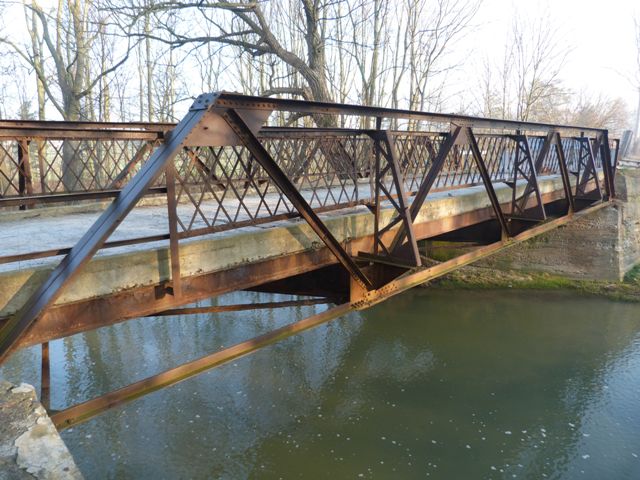We Recommend:
Bach Steel - Experts at historic truss bridge restoration.
BridgeHunter.com Phase 1 is released to the public! - Visit Now
Porter Bridge
Marburg Bridge

Primary Photographer(s): Nathan Holth
Bridge Documented: March 20, 2012
Rural: Norfolk County, Ontario: Canada
By Builder/Contractor: Unknown
Not Available or Not Applicable
Not Available
Not Available
Not Available
1 Main Span(s)
Not Applicable

View Information About HSR Ratings
Bridge Documentation
This bridge no longer exists!
Bridge Status: As of 2024, Reported as collapsed and removed by the county.View A Bridge Inspection Report For This Bridge
This bridge is one of a rapidly decreasing number of surviving riveted metal truss bridges in Ontario. This particular example retains excellent historic integrity with no significant alterations to the truss superstructure noted. Original lattice railings remain on the bridge. The heritage qualities of the bridge appear to be appreciated by a number of local residents. The bridge has been closed to traffic due to deterioration. Norfolk County has been seeking to demolish and replace bridge. Outcry from the local community caused the county to give greater consideration to rehabilitating the heritage bridge instead of replacing it.
The first consulting engineering firm that Norfolk County approached to analyze the bridge was G. Douglas Vallee Limited. Later, an April 9, 2012 Simcoe Reformer news article By Monte Sonnenberg, reported that the firm's engineer "will not lend his stamp to a project that keeps in place a single-lane bridge." The reasons given for this refusal included liability and safety concerns. The immediately proceeded to try to sell the county on a typical ugly modern concrete bridge.
Every engineer who produces plans for bridge work has to put their "stamp" on the design plans, which ties the plans, and the resulting construction they outline, to the engineer who signed off on them, and placed their stamp on the plans. Each engineer has the right to refuse to do work based on his or her judgment. However HistoricBridges.org strongly believes that an engineer who from step one is going to absolutely refuse to even consider the rehabilitation of a heritage bridge just because the bridge is one-lane (as many heritage bridges are) should not be a consultant for projects involving one-lane heritage bridges. Hiring a consultant who refuses to even consider rehabilitation of a heritage bridge will be unable to give a fair, balanced assessment of alternatives for the project, and will likely instead jump right to trying to sell a demolition and replacement project, with no serious consideration given to rehabilitation, despite the reality that rehabilitation might cost less and still meet the needs for the roadway. As such, hiring such a consulting engineer for projects involving heritage bridges should be reconsidered by the bridge owner. Instead, an engineer who is comfortable working with one lane heritage bridges needs to be sought. Engineers who have a deep and varied portfolio of experience successfully rehabilitating heritage bridges understand the ways in which a one-lane bridge can be made safe. Each bridge and its surrounding conditions are unique, but many methods exist and can be considered for each project. A few examples include traffic control: stop signs or even stop light signals at each end of the bridge to control the flow of traffic over the bridge, reduced speeds in the area of the bridge, or even improvement of the approach road grade to improve driver vision while crossing the bridge.
![]()
Photo Galleries and Videos: Porter Bridge
Bridge Photo-Documentation
Original / Full Size PhotosA collection of overview and detail photos. This gallery offers photos in the highest available resolution and file size in a touch-friendly popup viewer.
Alternatively, Browse Without Using Viewer
![]()
Bridge Photo-Documentation
Mobile Optimized PhotosA collection of overview and detail photos. This gallery features data-friendly, fast-loading photos in a touch-friendly popup viewer.
Alternatively, Browse Without Using Viewer
![]()
Maps and Links: Porter Bridge
This historic bridge has been demolished. This map is shown for reference purposes only.
Coordinates (Latitude, Longitude):
Search For Additional Bridge Listings:
Additional Maps:
Google Streetview (If Available)
GeoHack (Additional Links and Coordinates)
Apple Maps (Via DuckDuckGo Search)
Apple Maps (Apple devices only)
Android: Open Location In Your Map or GPS App
Flickr Gallery (Find Nearby Photos)
Wikimedia Commons (Find Nearby Photos)
Directions Via Sygic For Android
Directions Via Sygic For iOS and Android Dolphin Browser

